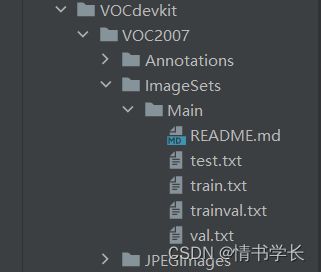VOC数据集转换为CoCo数据集(亲测有效)
#VOC数据集格式
VOC格式的数据集分为3部分,Annotations、ImageSets、JPEGImages。
(一) Annotations:存放数据标注的xml文件,格式如下:
CUMID_train
0001.png
C:\Users\86182\Desktop\CUMID_train\0001.png
Unknown
2040
1368
3
0
(二)ImageSets:存放数据分配的txt文件,文件中存放的是图像文件名称;
(三)JPEGImages:存放图像数据文件;
#CoCo数据集格式
不同于VOC格式一个xml文件对应一张图像,CoCo格式数据集的标签文件是集中在一个json文件中的,json文件内部包含3部分:images、annotations、categeories。
CoCo #根目录
annotations
instances_train2017.json:训练集标注
instances_val2017.json:验证集标注
train2017:训练集图像
val2017:验证集图像
json文件内部具体如下:
(一)images:存放图像名称以及大小
{
"file_name": "img-1.png",
"height": 720,
"width": 720,
"id": 0
},(二)annotations:存放边框位置坐标、类别、图像id等信息
{
"area": 43507,
"iscrowd": 0,
"image_id": 0,
"bbox": [
212,
239,
313,
139
],
"category_id": 1,
"id": 1,
"ignore": 0,
"segmentation": [
[]
]
},(三)categeories:存放数据集类别
{
"supercategory": "none",
"id": 1,
"name": "pothole"
}#vocTococo
#!/usr/bin/python
# pip install lxml
import sys
import os
import json
import xml.etree.ElementTree as ET
START_BOUNDING_BOX_ID = 1
PRE_DEFINE_CATEGORIES = {}
# If necessary, pre-define category and its id
# PRE_DEFINE_CATEGORIES = {"aeroplane": 1, "bicycle": 2, "bird": 3, "boat": 4,
# "bottle":5, "bus": 6, "car": 7, "cat": 8, "chair": 9,
# "cow": 10, "diningtable": 11, "dog": 12, "horse": 13,
# "motorbike": 14, "person": 15, "pottedplant": 16,
# "sheep": 17, "sofa": 18, "train": 19, "tvmonitor": 20}
PRE_DEFINE_CATEGORIES = {"pothole": 1}
def get(root, name):
vars = root.findall(name)
return vars
def get_and_check(root, name, length):
vars = root.findall(name)
if len(vars) == 0:
raise NotImplementedError('Can not find %s in %s.'%(name, root.tag))
if length > 0 and len(vars) != length:
raise NotImplementedError('The size of %s is supposed to be %d, but is %d.'%(name, length, len(vars)))
if length == 1:
vars = vars[0]
return vars
def get_filename_as_int(filename):
try:
filename = os.path.splitext(filename)[0]
return int(filename)
except:
raise NotImplementedError('Filename %s is supposed to be an integer.'%(filename))
def convert(xml_list, xml_dir, json_file):
list_fp = open(xml_list, 'r')
json_dict = {"images": [], "annotations": [],
"categories": []}
categories = PRE_DEFINE_CATEGORIES
bnd_id = START_BOUNDING_BOX_ID
image_counter = 0 # 添加一个计数器变量
for line in list_fp:
line = line.strip()
line = line + ".xml"
print("Processing %s"%(line))
xml_f = os.path.join(xml_dir, line)
tree = ET.parse(xml_f)
root = tree.getroot()
path = get(root, 'path')
if len(path) == 1:
filename = os.path.basename(path[0].text)
elif len(path) == 0:
filename = get_and_check(root, 'filename', 1).text
else:
raise NotImplementedError('%d paths found in %s'%(len(path), line))
## The filename must be a number
# image_id = get_filename_as_int(filename)
image_id = image_counter # 使用计数器作为image的id
image_counter += 1 # 递增计数器
size = get_and_check(root, 'size', 1)
width = int(get_and_check(size, 'width', 1).text)
height = int(get_and_check(size, 'height', 1).text)
image = {'file_name': filename, 'height': height, 'width': width,
'id':image_id}
json_dict['images'].append(image)
## Cruuently we do not support segmentation
# segmented = get_and_check(root, 'segmented', 1).text
# assert segmented == '0'
for obj in get(root, 'object'):
category = get_and_check(obj, 'name', 1).text
if category not in categories:
new_id = len(categories)
categories[category] = new_id
category_id = categories[category]
bndbox = get_and_check(obj, 'bndbox', 1)
xmin = int(get_and_check(bndbox, 'xmin', 1).text) - 1
ymin = int(get_and_check(bndbox, 'ymin', 1).text) - 1
xmax = int(get_and_check(bndbox, 'xmax', 1).text)
ymax = int(get_and_check(bndbox, 'ymax', 1).text)
assert(xmax > xmin)
assert(ymax > ymin)
o_width = abs(xmax - xmin)
o_height = abs(ymax - ymin)
ann = {'area': o_width*o_height, 'iscrowd': 0, 'image_id':
image_id, 'bbox': [xmin, ymin, o_width, o_height],
'category_id': category_id, 'id': bnd_id, 'ignore': 0,
'segmentation': [[]]}
json_dict['annotations'].append(ann)
bnd_id = bnd_id + 1
for cate, cid in categories.items():
cat = {'supercategory': 'none', 'id': cid, 'name': cate}
json_dict['categories'].append(cat)
json_fp = open(json_file, 'w')
json_str = json.dumps(json_dict)
json_fp.write(json_str)
json_fp.close()
list_fp.close()
if __name__ == '__main__':
xml_list = r'E:\code\python\2\VOCdevkit\VOC2007\ImageSets\Main\val.txt'
# xml_list = './data/VOCdevkit/ImageSets/Main/val.txt'
xml_dir = r'E:\code\python\2\VOCdevkit\VOC2007\Annotations\val'
# json_dir = './data/COCO/annotations/test.json' # 注意!!!这里test.json先要自己创建,不然
json_dir = r'E:\code\python\2\VOCdevkit\instances_val2017.json'
convert(xml_list, xml_dir, json_dir)
修改步骤:
1、PRE_DEFINE_CATEGORIES:换成自己的类别
2、xml_list:内容替换为自己的.txt文件,文件中存放的是图像名称
3、xml_dir:内容替换为自己的.xml文件夹,存放的是xml文件
4、json_dir:自定义生成的json文件位置
5、把train和val分开运行2次即可
